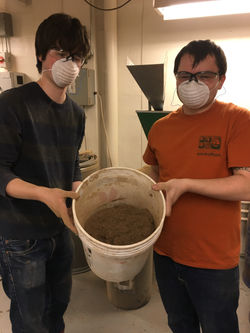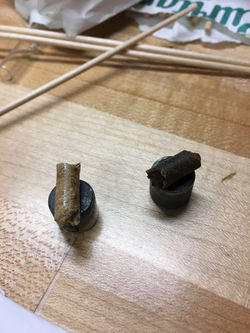

Doctor of Philosophy (PhD)
in
Biomaterials Engineering
Research
State University of New York
College of Environmental Science and Forestry
(SUNY-ESF)
My PhD Research investigated fuel pellets and the effect of hot water extraction as a biomass pretreatment on fuel pellet properties. Additionally, I examined the effects of utilizing lignin recovered from the hot water extraction process as an additive during pelletization and the effect of this lignin on fuel pellet properties.
My General Research Questions were:
-
What is the effect of hot water extraction pretreatment of biomass on fuel pellet properties?
-
What is the effect of utilizing lignin recovered from the hot water extraction process as an additive in fuel pellets?
My Null and Alternate Hypotheses were:
-
H0: The hot water extraction of biomass for fuel pellets did not have a (statistically) significant effect on fuel pellet properties (mi = mj)
Ha: The hot water extraction of biomass for fuel pellets did have a (statistically) significant effect on fuel pellet properties (mi ≠ mj) -
H0: The addition of recovered lignin to fuel pellets did not have a (statistically) significant effect on fuel pellet properties (mk = ml = mm)
Ha: The addition of recovered lignin to fuel pellets did have a (statistically) significant effect on fuel pellet properties (mk ≠ ml ≠ mm)

Lignocellulosic Materials

Three lignocellulosic materials were utilized for this research: Shrub Willow, Miscanthus, and Wheat Straw [pictured left to right]. Each biomass was pretreated with hot water extraction prior to the pelletization process [pictured in bottom row].
Lignin Recovery

Hot water extraction resulted in two main streams: solid lignocellulosic biomass and liquid hydrolysate. The solid biomass was air dried and utilized for fuel pellets [pictured top left]. The liquid hydrolysate contained hemicellulosic sugars and lignin [pictured top right]. The hydrolysate was acidified to pH-2 to precipitate the lignin from the hydrolysate. The hydrolysate was then decanted from the container and the lignin was recovered [pictured bottom left] to be washed, dried [pictured bottom right], and applied to biomass during the pelletization process.
Pelletizing

Two pelletizers were used for making fuel pellets of different treatments. The large-scale pelletizer was a flat-die pelletizer located off-site in Tully, NY [pictured right]. A small-scale ring-die pelletizer was located on-site in Syracuse, NY [pictured left]. Each lignocellulosic material was ground into 6 mm and 3 mm particle size prior to large-scale pelletization, and 3 mm and 1 mm particle size for small scale pelletization. Lignin-addition pelletization occurred only with the small-scale pelletizer.
Hot Water Extraction

Hot water extraction was performed at the pilot scale for each of the three lignocellulosic materials. The pilot scale reactor had a volume of 65 cubic feet or 1841 Liters [pictured above]. The process used steam and pressure to remove hemicelluloses (particularly xylans) from biomass, notably angiosperms. A portion of lignin was also removed during the process. The extraction occurred for two hours at approximately 160 degrees Celsius.
Grinding

Biomass was ground to various particle sizes utilizing two hammermills. One hammermill was a small-scale machine capable of reducing particle size to 6 mm, 3 mm, and approximately 1 mm dimensions [pictured left]. The other hammermill was a large-scale device capable of reducing particle size to 6 mm at a quicker speed than the small-scale hammermill [pictured right].
Pellet Properties

Various pellet properties were tested to examine the impact of the hot water extraction and lignin addition treatments. These properties included:
-
Bulk Density
-
Pellet Density and Dimensions
-
Durability
-
Moisture Content
-
Ash Content
-
Moisture Absorption
-
Calorific Value
-
Carbon Monoxide (CO) Emissions
Most of these properties were measured following an associated ISO method with limited modifications where necessary. Moisture Absorption and CO emissions did not follow an ISO method, but did utilize methods influenced by literature in the field. An example of an emissions apparatus is pictured above.

Additional Research Photos
(Click the Image for a Larger View)
 Supersacks of Lignocellulosic Biomass Ready for Processing. |  The IST Pilot Plant Crew Assisting in Hot Water Extracting Lignocellulosic Biomass at the Pilot Scale. Here They are Moving Supersacks to Load into the Pilot Scale Reactor. |  The IST Pilot Plant Crew Assisting in Hot Water Extracting Lignocellulosic Biomass at the Pilot Scale. Here They are Loading Lignocellulosics into the Pilot Scale Reactor. |
|---|---|---|
 Inside View of Wheat Straw Loaded in the Pilot Scale Reactor for Hot Water Extraction. |  Here I am Helping Push Out Hot Water Extracted Biomass From the Top of the Reactor Out of the Bottom. |  Undergraduate Student Researchers Assisting with Handling Biomass and Grinding/Hammermilling. |
 Undergraduate Student Researchers Assisting with Handling Biomass and Grinding/Hammermilling. |  Undergraduate Student Researchers Assisting with Handling Biomass and Grinding/Hammermilling. |  Hot water extracted biomass on a sieving screen. The hot water extracted material was light caught on itself, which made it difficult to feed it through the pelletizer. |
 First Lignocellulosic Pellets Made on the Laboratory Scale Pelletizer. These Were Made from Ash to Test the Pelletizer. |  First Set of Hot Water Extracted Willow and Willow Pellets Made on the Laboratory Pelletizer. |  Buckets of Pellets Made from Pilot Scale Pelletizer with a Bag of Commercial Pellets. |
 Experimentation of Lignin Addition by Spraying Biomass with a Lignin Acetone Mixture. Sprayed Biomass is on the Right. Solid Powdered Lignin was Utilized for Laboratory Scale Research Instead of Spraying. |  Commercial lignin, lignin recovered from hot water extraction, and washed lignin recovered from hot water extraction. The first two lignins were utilized in this research. |  Lignin formed into a pellet for energy content analysis. |
 Greenhouse GC Experimentation for CO Measurement. Here is the GC Equipment. The Greenhouse GC Was Not Able to Measure CO, so USB CO Sensors Were Used Instead. |  Greenhouse GC Experimentation for CO Measurement. Here is a Tray of Standard Samples for Experimentation. The Greenhouse GC Was Not Able to Measure CO, so USB CO Sensors Were Used Instead. |  Soxhlet Extraction of Lignocellulosic Biomass for Fatty Acid Analysis and CO Off-Gassing. Here are the Samples in the Soxhlet Apparatuses. |
 Soxhlet Extraction of Lignocellulosic Biomass Samples for Fatty Acid Analysis and CO Off-Gassing. Here are Extractives in Solvent After the Soxhlet Extraction Process. |  Residues from Soxhlet Extractions Drying in Evaporation Dishes in a Vacuum Oven. |  Extractives from Soxhlet Extraction Experiments Stored in Scintillation Vials and Solvent. Biomass was Extracted in a Sequence of Three Solvents from Non-Polar to Polar. |
 Extractives ready for GC-MS analysis for fatty acids. |  GC-MS vials containing extractives samples for fatty acid analysis. |  Solvent extracted wood pellets for analysis of carbon monoxide emissions. |
 Experimentation with SEM of Lignocellulosic Pellets. The Pellets Were Mounted with Carbon Paint. These are Pellets Made from Willow and HWE Willow. |  The Sputter Coater Utilized for SEM Experimentation of Pellets. |  Pellets After Sputter Coating Gold-Palladium. Pellets Are Ready for SEM. |
 Sputter Coated Pellets Placed in Holder for SEM Analysis. |  Sample SEM Photo of HWE Willow Pellet (Left) and Willow Pellet (Right) with a Secondary Electron Detector (SED). Additional SEM Analysis is a Suggested Future Work Study of this Research. |  Pellets from the Pilot Scale run in eight ounce Mason Jars. These are made from willow and Hot Water Extracted willow (left to right) and biomass ground with a 6 mm screen (top) and a 3 mm screen (bottom). |
 Pellets from the Pilot Scale run in eight ounce Mason Jars. These are made from wheat straw and Hot Water Extracted wheat straw (left to right) and biomass ground with a 6 mm screen (top) and a 3 mm screen (bottom). |  Pellets from the Pilot Scale run in eight ounce Mason Jars. These are made from miscanthus and Hot Water Extracted miscanthus (left to right) and biomass ground with a 6 mm screen (bottom) and a 3 mm screen (top). |  Pellets utilized in the pellet length measurement for this research. The image was extracted from the dissertation produced from this research. |
 A mixture of pellets made from the Pilot Scale Pelletizer. This consists of pellets made from willow, miscanthus, and wheat straw and their Hot Water Extracted counterparts. |
Relevant Course Work
Microscopy | Chemistry | Lignocellulosics |
|---|---|---|
Scanning Electron Microscopy | Polymer Science: Properties and Techniques | Biomass Energy |
Fundamentals of Microscopy | Polymer Science: Synthesis and Mechanisms | Chemistry of Lignocellulosic Biomass (Graduate Level) |
Analytical Chemistry II |